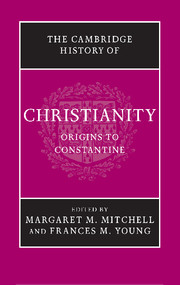Book contents
- Frontmatter
- Prelude: Jesus Christ, foundation of Christianity
- Part I The Political, Social and Religious Setting
- Part II The Jesus Movements
- Part III Community Traditions and Self-Definition
- 8 The emergence of the written record
- 9 Marcion and the ‘canon’
- 10 Self-definition vis-à-vis the Jewish matrix
- 11 Self-definition vis-à-vis the Graeco-Roman world
- 12 Self-differentiation among Christian groups: the Gnostics and their opponents
- 13 Truth and tradition: Irenaeus
- 14 The self-defining praxis of the developing ecclēsia
- Part IV Regional Varieties of Christianity in the First Three Centuries
- Part V The Shaping of Christian Theology
- Part VI ‘Aliens’ become Citizens: towards Imperial Patronage
- Conclusion: retrospect and prospect
- Bibliographies
- Index
- Map 1. The Roman Empire in the time of Marcus Aurelius
- References
8 - The emergence of the written record
from Part III - Community Traditions and Self-Definition
Published online by Cambridge University Press: 28 March 2008
- Frontmatter
- Prelude: Jesus Christ, foundation of Christianity
- Part I The Political, Social and Religious Setting
- Part II The Jesus Movements
- Part III Community Traditions and Self-Definition
- 8 The emergence of the written record
- 9 Marcion and the ‘canon’
- 10 Self-definition vis-à-vis the Jewish matrix
- 11 Self-definition vis-à-vis the Graeco-Roman world
- 12 Self-differentiation among Christian groups: the Gnostics and their opponents
- 13 Truth and tradition: Irenaeus
- 14 The self-defining praxis of the developing ecclēsia
- Part IV Regional Varieties of Christianity in the First Three Centuries
- Part V The Shaping of Christian Theology
- Part VI ‘Aliens’ become Citizens: towards Imperial Patronage
- Conclusion: retrospect and prospect
- Bibliographies
- Index
- Map 1. The Roman Empire in the time of Marcus Aurelius
- References
Summary
A battle of literatures
The oldest Christian text in Latin contains the following interrogation of a North African Christian:
Saturninus the procunculs said ‘what are those things in your case?’
Speratus replied, ‘books and letters of Paul, a just man.’
Although it is uncertain whether these ‘books and letters of Paul’ were produced by the defendant Speratus as evidence (and, if so, whether voluntarily or on judicial order), or brought along for the instruction and consolation of the prisoners, this encounter highlights the crucial link between Christian identity and Christian texts. In February 303, Diocletian waged a persecutorial campaign against the Christian movement by legislating three strategic actions. Tellingly, the second of these – the handing over and public burning of its texts – was deemed by the emperor as crucial to the demolition of this cult as the razing of churches and civil disenfranchisement of its leaders. His diagnosis was apparently shared by his persecutorial successor, Maximinus Daia, who countered the threat of the Christian scriptures by the composition and enforced propagandisation of a counter-literature, the ‘Memoirs of Pilate and the Saviour’ that were to be handed on to schoolchildren for memorisation. These early fourth-century bibliographic broadsides were not to prove successful (indeed, to the distress of historians no single copy remains of the ‘Memoirs of Pilate and the Saviour’) Eusebius found the ultimate victory of the Christian literature in the emperor Constantine’s celebratory commissioning of fifty resplendent copies of the scriptures (Old and New Testament) for distribution and use in and around the newly founded capital of his now-Christian empire.
Keywords
- Type
- Chapter
- Information
- The Cambridge History of Christianity , pp. 175 - 194Publisher: Cambridge University PressPrint publication year: 2006
References
- 3
- Cited by

